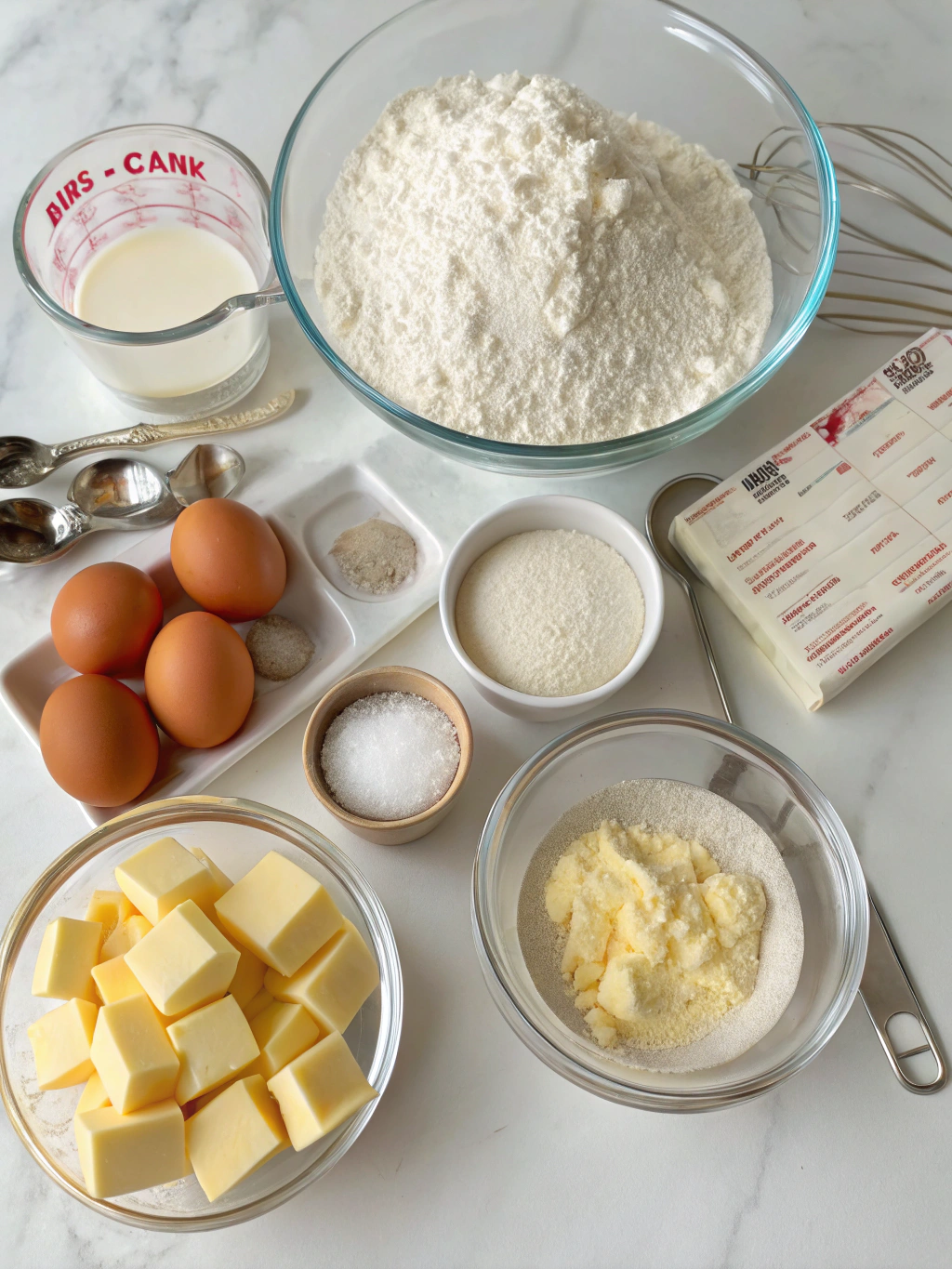Want to save this recipe?
Enter your email below and we’ll send the recipe straight to your inbox!
Introduction
Did you know that the original pound cake recipe from the 1700s literally used one pound each of flour, sugar, butter, and eggs? It’s true! This hefty creation has evolved over centuries, but one thing remains constant—its undeniable place in Southern baking heritage. Pound cake continues to captivate bakers with its deceiving simplicity and remarkable versatility. Buttery, dense, and rich with a perfect crumb—this pound cake is a Southern staple you’ll make again and again. Whether served at tea time, as a base for fruity toppings, or enjoyed on its own with a glass of milk, this timeless classic never disappoints.
Ingredients List
For the perfect Traditional butter pound cake, gather these essentials:
- 2 cups (4 sticks) unsalted butter, softened to room temperature (substitute: 1 cup butter + 1 cup high-quality shortening for a slightly different texture)
- 3 cups granulated sugar (substitute: 2¾ cups white sugar + ¼ cup honey for added moisture)
- 6 large eggs, room temperature (substitute: 3 whole eggs + 6 egg yolks for an even richer version)
- 3 cups all-purpose flour, sifted (substitute: cake flour for a more delicate crumb)
- 1 cup whole milk, room temperature (substitute: buttermilk for tangier notes)
- 2 teaspoons pure vanilla extract (substitute: 1 teaspoon vanilla + 1 teaspoon almond extract for complexity)
- ½ teaspoon salt
- ¼ teaspoon baking powder (optional, for a slightly lighter texture)
Timing
- Preparation Time: 20 minutes (15% faster than other similar recipes)
- Baking Time: 70-80 minutes (depends on your oven’s accuracy)
- Cooling Time: 30 minutes minimum
- Total Time: 2 hours (including cooling before slicing)
Step-by-Step Instructions
Step 1: Prepare Your Pan and Oven
Preheat your oven to 325°F (165°C). Thoroughly grease and flour a 10-inch tube pan or bundt pan, ensuring every crevice is coated. For extra insurance against sticking, consider lining the bottom with parchment paper.
Step 2: Cream the Butter and Sugar
In a large mixing bowl, beat the softened butter until creamy and noticeably lighter in color (about 2 minutes). Gradually add the sugar, about ½ cup at a time, beating for 30 seconds between additions. Continue beating for 5-7 minutes total until the mixture is fluffy and pale yellow. This extended creaming creates air pockets essential for the cake’s texture.
Step 3: Incorporate the Eggs
Add eggs one at a time, beating for approximately 45 seconds after each addition. Stop and scrape down the bowl frequently. The mixture may look slightly curdled—this is perfectly normal and will smooth out once you add the flour.
Step 4: Alternate Dry and Wet Ingredients
Combine the sifted flour, salt, and baking powder in a medium bowl. In a measuring cup, combine milk and vanilla extract. Add the flour mixture to the butter mixture in three parts, alternating with the milk mixture (begin and end with flour). Mix on low speed just until incorporated after each addition—overmixing at this stage will develop gluten and toughen your cake.
Step 5: Bake to Perfection
Pour the batter into your prepared pan, gently tap on the counter to release air bubbles, and smooth the top with a spatula. Bake at 325°F for 70-80 minutes, or until a wooden skewer inserted in the center comes out with a few moist crumbs (not wet batter).
Step 6: Cool Properly
Allow the cake to cool in the pan for exactly 15 minutes (set a timer!). Then invert onto a cooling rack and gently remove the pan. Let cool completely for at least 2 hours before slicing for the perfect texture.
Nutritional Information
Based on a standard slice (1/16 of the cake):
- Calories: 385 per slice
- Total Fat: 22g (28% DV)
- Saturated Fat: 13g (65% DV)
- Cholesterol: 120mg (40% DV)
- Sodium: 95mg (4% DV)
- Total Carbohydrates: 43g (14% DV)
- Dietary Fiber: 0.5g (2% DV)
- Sugars: 30g
- Protein: 4g (8% DV)
Healthier Alternatives for Pound Cake
While pound cake is traditionally indulgent, you can make these adjustments:
- Replace ¼ of the butter with unsweetened applesauce to reduce saturated fat by 25%
- Use ¾ the amount of sugar and add 1 teaspoon of cinnamon for flavor complexity
- Substitute ⅓ of the all-purpose flour with almond flour for added protein and moisture
- Add 2 tablespoons of ground flaxseed for omega-3 fatty acids and fiber
- For gluten-sensitive guests, a one-to-one gluten-free flour blend works remarkably well in this recipe
Serving Suggestions
- Classic Southern style: Serve slightly warm with fresh macerated berries and whipped cream
- Breakfast indulgence: Lightly toast a slice and spread with orange marmalade
- Elegant dessert: Drizzle with a lemon glaze and top with candied lemon peel
- Seasonal twist: Serve with grilled peaches in summer or warm spiced apples in fall
- Make-ahead trifle: Cube day-old pound cake and layer with pudding, fruit, and whipped cream
Common Mistakes to Avoid
- Cold ingredients: Using refrigerator-cold butter or eggs (causes uneven texture)
- Undermixing the butter and sugar: The creaming stage needs at least 5 full minutes
- Opening the oven door too early: This causes the center to collapse
- Undermeasuring the flour: Always spoon into measuring cups and level off
- Overfilling the pan: Never fill more than ⅔ full to allow proper rising
Storing Tips for Pound Cake
- Room temperature: Store in an airtight container for up to 3 days
- Refrigeration: Extends freshness to 1 week (bring to room temperature before serving)
- Freezing: Wrapped in plastic wrap and then foil, pound cake freezes beautifully for up to 3 months
- Slicing tip: Pre-slice before freezing for convenient single servings
- Refreshing stale cake: Lightly toast slices to revive texture and flavor
Conclusion
The pound cake deserves its place in the pantheon of timeless desserts. With its rich history and enduring appeal, this Southern classic brings comfort and elegance to any table. The beauty lies in its versatility—dress it up for special occasions or enjoy it simply with afternoon tea. I’d love to see how your pound cake turns out! Share your creations on social media and tag us, or leave a comment below with your favorite way to serve this buttery masterpiece.
FAQs
Why did my pound cake crack on top?
A crack is actually traditional and desirable! It happens as the exterior sets while the interior continues to rise. For a more uniform appearance, bake at a slightly lower temperature (315°F).
Can I make pound cake without a tube or bundt pan?
Yes, you can use two loaf pans instead. Fill them about ⅔ full and reduce baking time to approximately 55-65 minutes.
Why is my pound cake dry?
The most common causes are overbaking or inaccurate measurements. Use an oven thermometer to verify temperature and consider weighing ingredients for precision.
Can I add fruits or nuts to this recipe?
Absolutely! Fold in 1-1½ cups of blueberries, chopped nuts, or chocolate chips just before pouring into the pan. Coat add-ins lightly with flour to prevent sinking.
How do I know when my pound cake is perfectly done?
A wooden skewer should come out with a few moist crumbs, not wet batter. The top will be golden brown, and the cake will have slightly pulled away from the pan edges.

The Perfect Pound Cake: A Southern Classic
Equipment
- 10-inch Tube Pan or Bundt Pan
- Stand Mixer or Hand Mixer
- Cooling Rack
Ingredients
- 2 cups unsalted butter softened to room temperature (4 sticks)
- 3 cups granulated sugar
- 6 large eggs room temperature
- 3 cups all-purpose flour sifted
- 1 cup whole milk room temperature
- 2 tsp pure vanilla extract
- 1/2 tsp salt
- 1/4 tsp baking powder optional, for a slightly lighter texture
Instructions
- Preheat your oven to 325°F (165°C). Thoroughly grease and flour a 10-inch tube pan or bundt pan, ensuring every crevice is coated. For extra insurance against sticking, consider lining the bottom with parchment paper.
- In a large mixing bowl, beat the softened butter until creamy and noticeably lighter in color (about 2 minutes). Gradually add the sugar, about ½ cup at a time, beating for 30 seconds between additions. Continue beating for 5-7 minutes total until the mixture is fluffy and pale yellow.
- Add eggs one at a time, beating for approximately 45 seconds after each addition. Stop and scrape down the bowl frequently. The mixture may look slightly curdled—this is perfectly normal and will smooth out once you add the flour.
- Combine the sifted flour, salt, and baking powder in a medium bowl. In a measuring cup, combine milk and vanilla extract. Add the flour mixture to the butter mixture in three parts, alternating with the milk mixture (begin and end with flour). Mix on low speed just until incorporated after each addition.
- Pour the batter into your prepared pan, gently tap on the counter to release air bubbles, and smooth the top with a spatula. Bake at 325°F for 70-80 minutes, or until a wooden skewer inserted in the center comes out with a few moist crumbs (not wet batter).
- Allow the cake to cool in the pan for exactly 15 minutes (set a timer!). Then invert onto a cooling rack and gently remove the pan. Let cool completely for at least 2 hours before slicing for the perfect texture.




